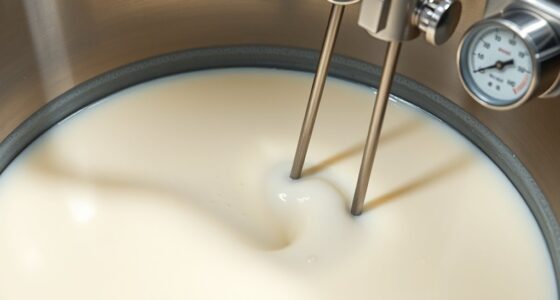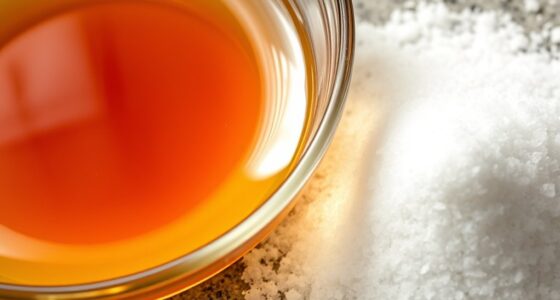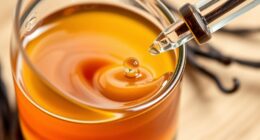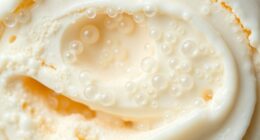Soft serve machines work by blending ingredients while controlling temperature, typically chilling the mixture to around 21°F (-6°C) to keep it soft yet firm. An auger or dasher continuously stirs the mixture, incorporating air to create a light, fluffy texture known as overrun. As it passes through the nozzle, the machine shapes a smooth swirl. For more details, you’ll find that understanding each step reveals how the final product stays perfect every time.
Key Takeaways
- Soft serve machines blend ingredients with controlled temperature, mixing speed, and air incorporation to create a smooth, creamy texture.
- They use refrigeration to chill the mixture to about 21°F (-6°C), maintaining softness and proper consistency.
- An auger or dasher continuously stirs the mixture, preventing ice crystals and ensuring uniform texture and lightness.
- The mixture passes through a nozzle during dispensing, forming the signature swirl with a consistent flow rate.
- Regular cleaning and calibration are essential for proper operation, preventing clogs and maintaining optimal swirl and texture.

Have you ever wondered how soft serve ice cream gets that perfectly smooth and creamy texture? The secret lies in the sophisticated technology behind soft serve machines, which carefully blend ingredients to create that irresistible swirl. These machines work by combining ice cream textures with precise control over temperature, mixing speed, and air incorporation. When you pull the handle, a series of mechanical and thermal processes kick into gear, transforming liquid ingredients into the luscious treat you enjoy. The key to achieving that signature smoothness is maintaining the right balance of ingredients and guaranteeing the machine is properly cared for. Regular machine maintenance is essential to keep everything running smoothly and to prevent issues like ice buildup or inconsistent textures.
Inside the machine, a refrigeration system chills the mixture to just the right temperature, usually around 21°F (-6°C). This low temperature keeps the ice cream soft enough to dispense but firm enough to hold its shape. The mixture is continuously stirred by an auger or dasher, which ensures the ice cream remains uniform and prevents ice crystals from forming. This constant movement also helps incorporate air into the mixture, giving soft serve its signature light and fluffy texture. The amount of air added, known as overrun, is carefully controlled to produce the desired ice cream textures—too much air results in a lighter, less dense product, while too little can make the ice cream feel heavy. Properly calibrated equipment ensures consistent overrun and texture, which is vital for quality.
As the mixture is dispensed, it passes through a nozzle where the swirl is formed. The machine’s design ensures the right flow rate and consistency, producing that iconic spiral presentation. To keep this process seamless, regular cleaning and maintenance are crucial. Residue buildup or clogged nozzles can disrupt ice cream textures and cause inconsistent serving. Proper machine maintenance involves cleaning parts regularly, checking for leaks, and calibrating temperature controls. Neglecting these steps can lead to mechanical failures or poor-quality ice cream.
In essence, a soft serve machine is a finely tuned system of refrigeration, mixing, and air incorporation that works harmoniously to deliver that smooth, creamy treat. Your role in maintaining the machine is essential—by keeping it clean and in good working order, you guarantee each cone or cup is as delicious and perfect as the last. Understanding how these machines work also helps you troubleshoot minor issues, preserving the quality of the ice cream and the efficiency of the machine. Additionally, knowing the importance of consistent machine calibration can prevent many common problems before they start. Ultimately, it’s this combination of advanced technology and diligent maintenance that allows you to serve up the irresistible soft serve everyone loves.
Frequently Asked Questions
How Energy-Efficient Are Soft Serve Machines?
Soft serve machines vary in energy efficiency, but many now feature eco-friendly options that reduce energy consumption. You’ll find models with advanced insulation and energy-saving modes, helping you lower electricity use while maintaining quality. By choosing machines with these eco-friendly features, you’re making a more sustainable choice that benefits the environment and reduces your operational costs. Overall, modern soft serve machines are designed to be energy-efficient without sacrificing performance.
What Maintenance Do Soft Serve Machines Require?
You need to perform regular cleaning procedures to keep your soft serve machine in top shape. This involves disassembling parts, sanitizing components, and making sure no residue remains. Additionally, check the component durability of key parts like the auger and freezing compressor, replacing them as needed to prevent breakdowns. Proper maintenance not only extends your machine’s lifespan but also ensures consistent, high-quality servings for your customers.
Can Soft Serve Machines Operate With Non-Dairy Products?
Imagine serving delicious vegan soft serve at your shop—yes, soft serve machines can handle non-dairy products! Many machines are versatile enough to operate with dairy alternatives like almond, soy, or coconut milk, offering vegan options. Just verify the machine’s mix and consistency are suitable, and consider cleaning protocols. With the right adjustments, you can easily cater to customers seeking dairy-free or vegan treats.
How Long Can Soft Serve Be Stored Before Serving?
You can typically store soft serve ice cream for a few hours before serving, but for ideal quality, follow the machine’s storage duration guidelines. Keep it refrigerated if stored longer, as soft serve needs consistent refrigeration requirements to maintain texture and safety. Avoid freezing it solid, as this can affect consistency. Always monitor temperature and storage time to ensure the best taste and safety for your guests.
Are There Safety Standards for Soft Serve Machine Manufacturing?
Safety standards shape soft serve machine manufacturing, ensuring your treat stays safe and satisfying. You’ll want to check for safety certifications, which verify compliance with strict manufacturing regulations. These regulations set the bar for hygiene, electrical safety, and operational reliability. So, when you buy or use a soft serve machine, you can feel confident knowing it meets essential safety standards, safeguarding your sweet experience every time.
Conclusion
Now that you know how soft serve machines create that irresistible swirl, imagine what’s happening behind the scenes each time you indulge. The precise balance of temperature, pressure, and ingredients keeps that perfect texture flowing. But here’s the twist—you might think you’ve seen it all, yet there’s always more innovation brewing in the background. So next time you enjoy a cone, wonder what secrets this fascinating technology might reveal next. The sweet surprise is just beginning.










